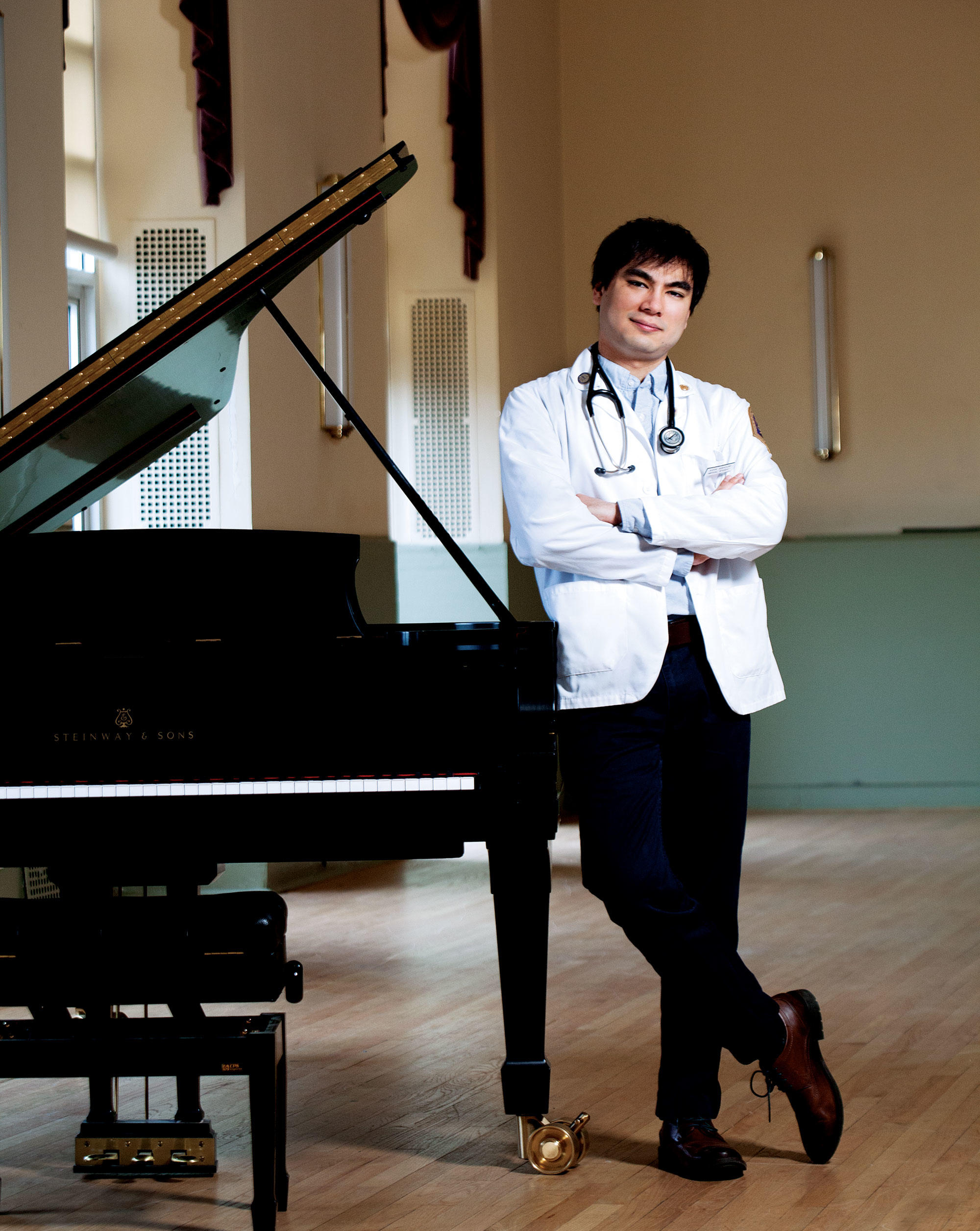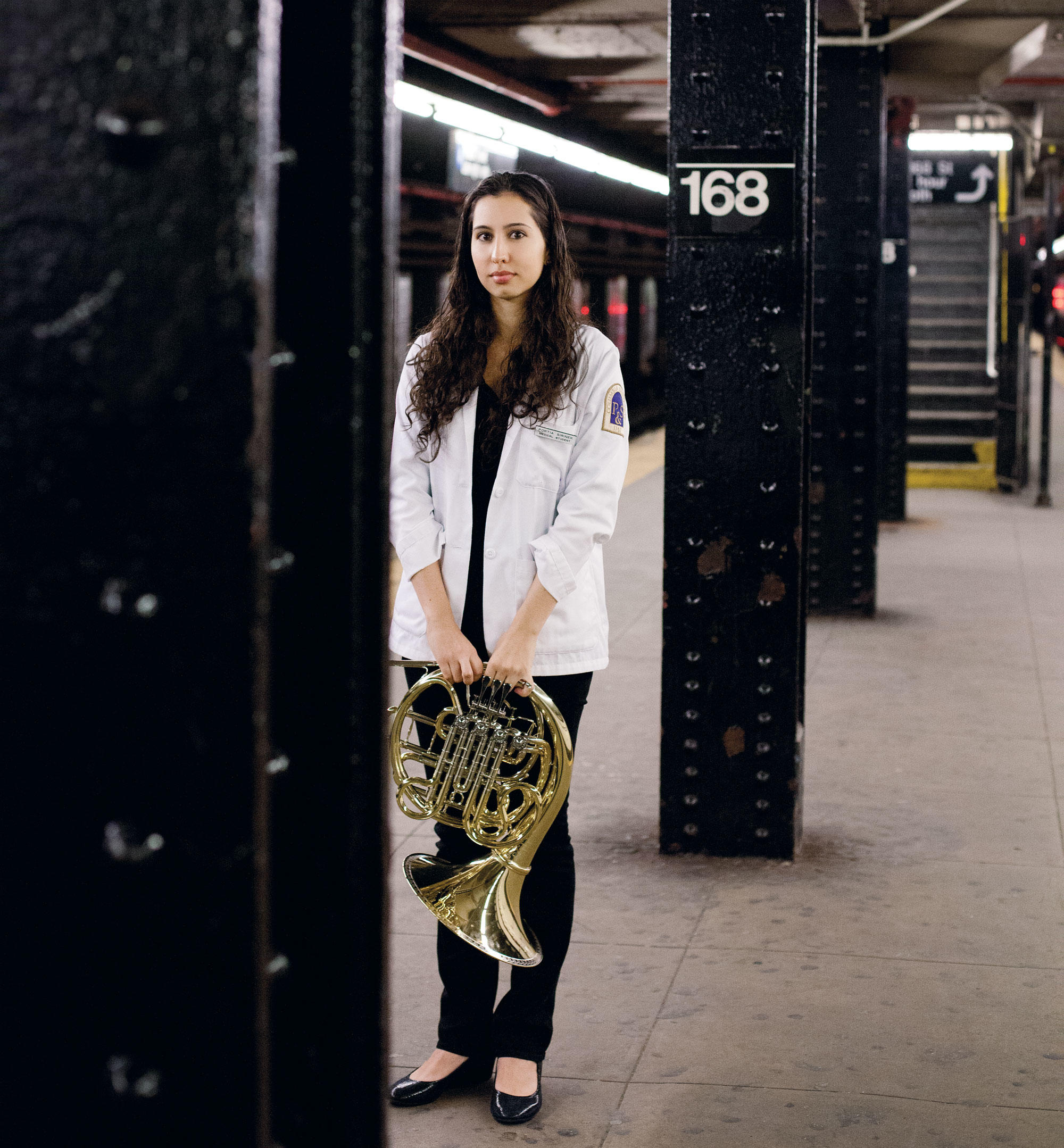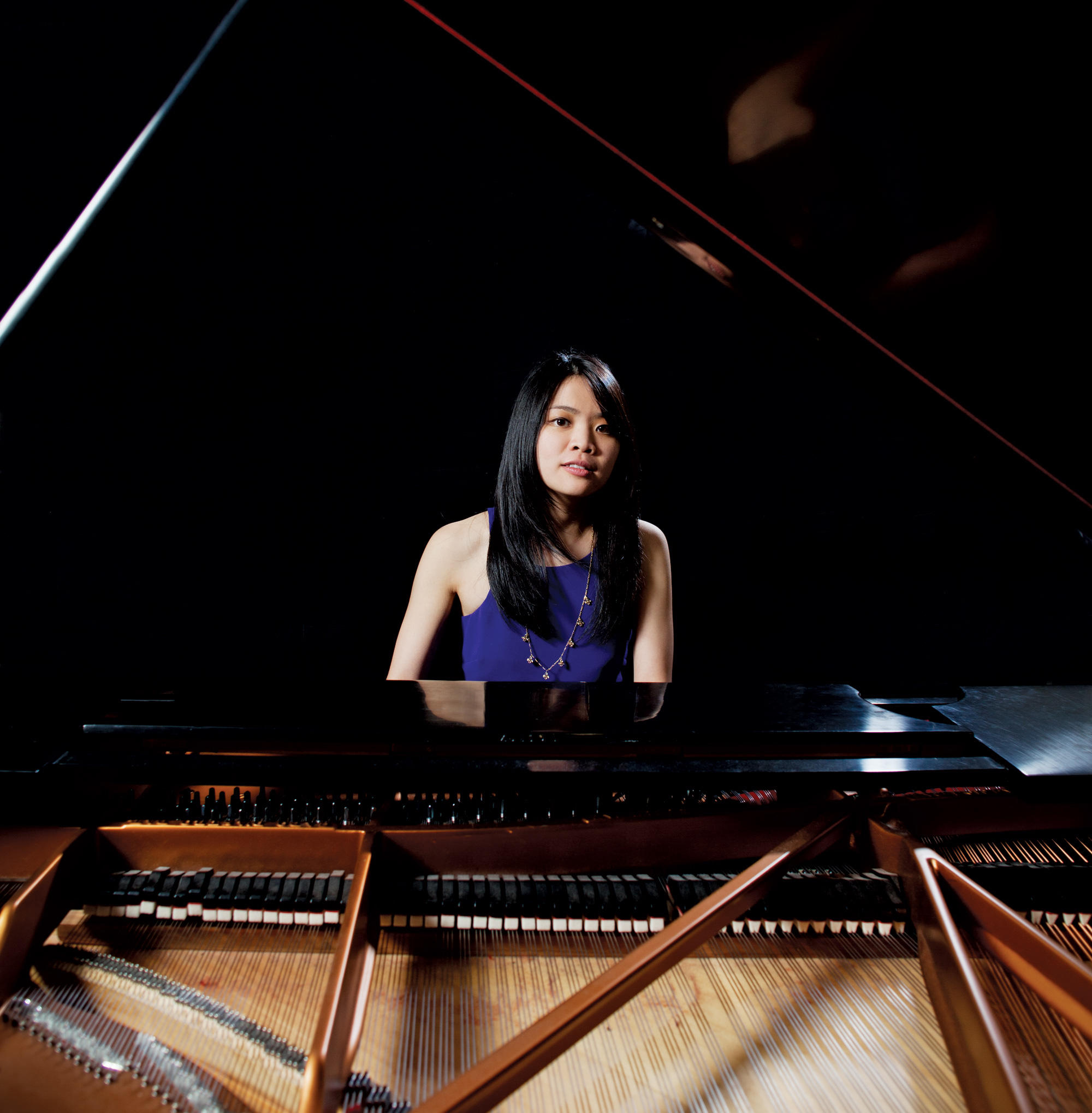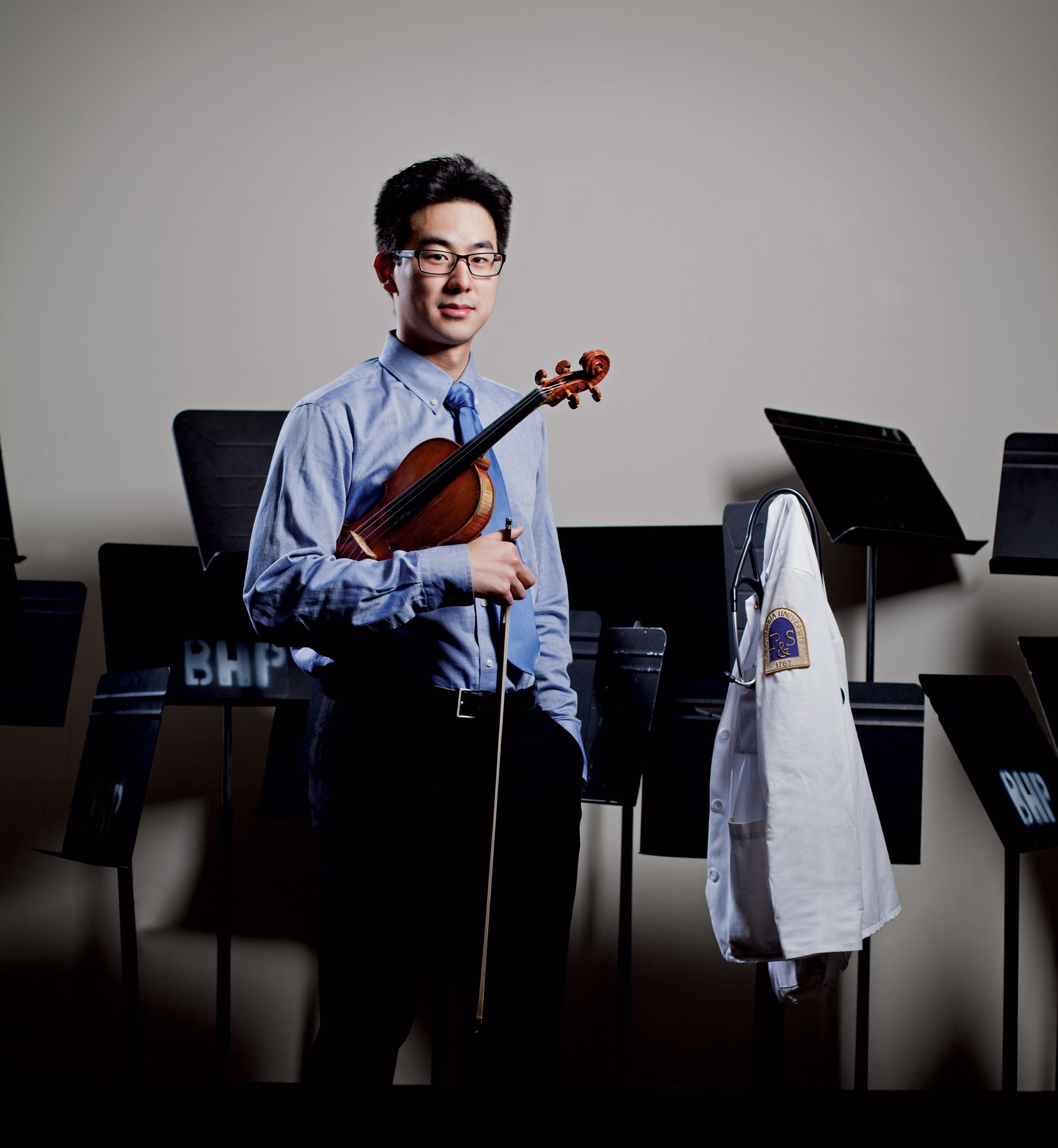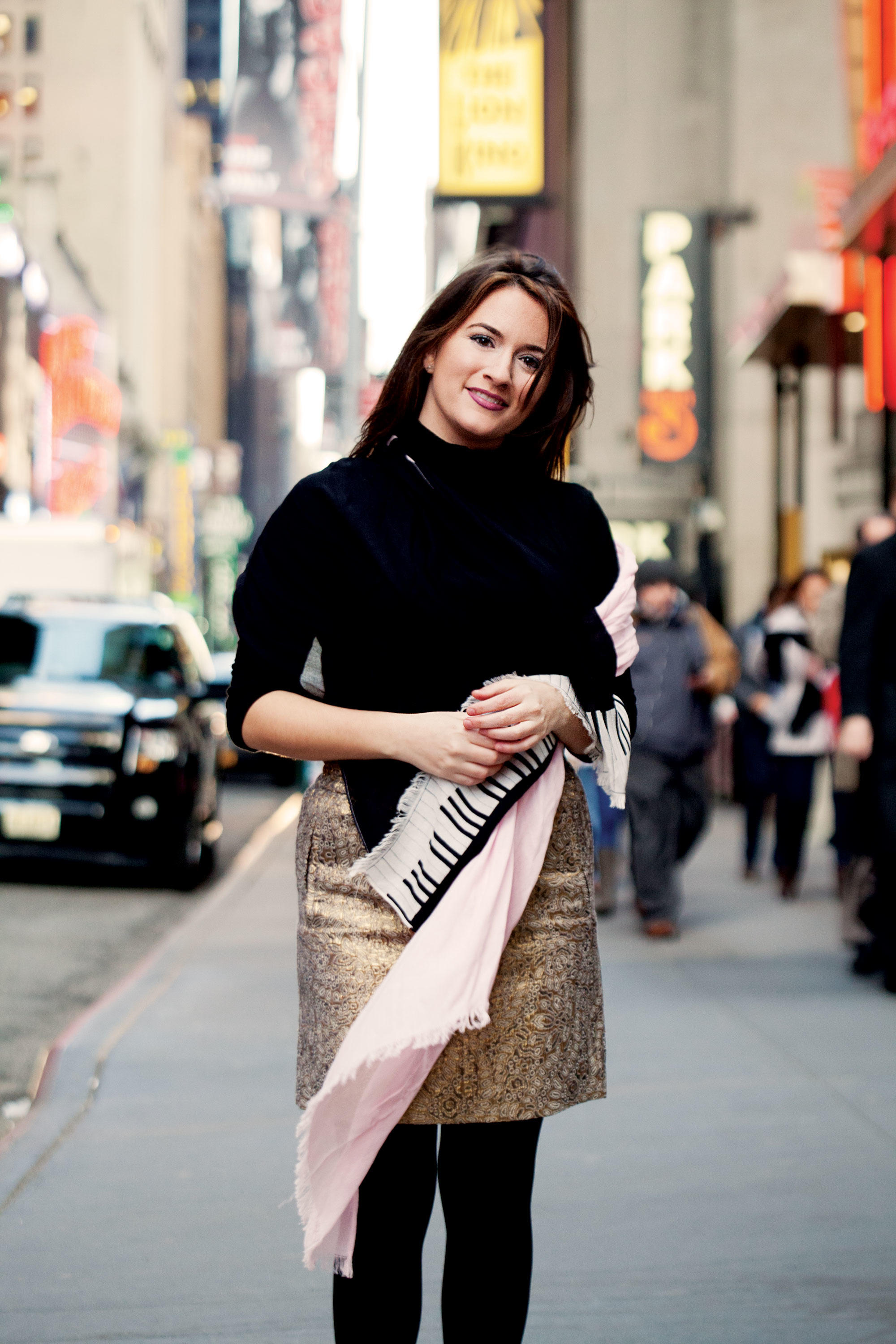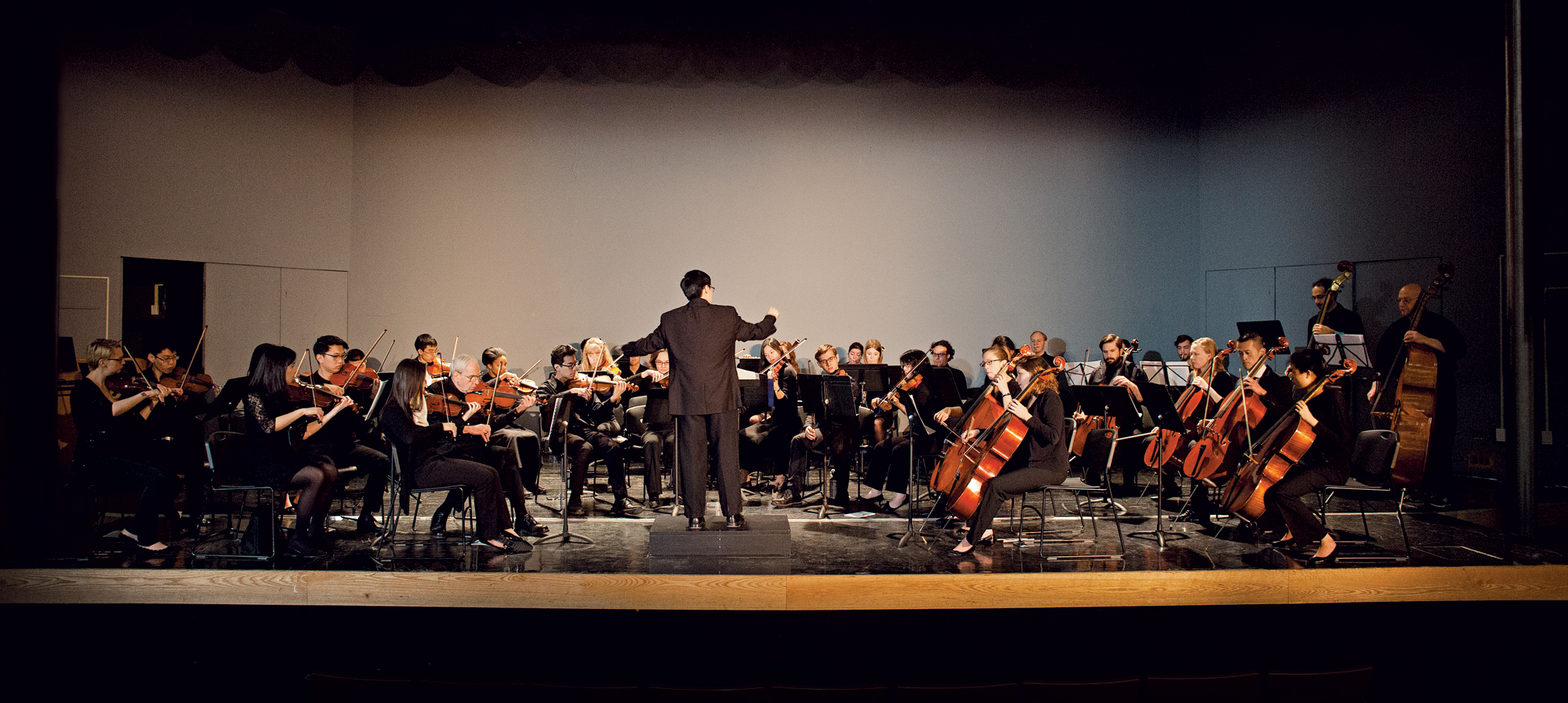
Two grand pianos face each other, fitted along their broad curves but not touching, like two continents early in their separation. At one piano, Aidin Ashoori, who weeks earlier had played Chopin at Carnegie Hall, adjusts his bench. At the other, Stephanie Chen, a Juilliard graduate, lifts her arms. Chen and Ashoori are set to attack Gershwin’s Concerto in F, the grand finale of an evening that included violinist Jeremy Ying sawing a Bach partita and pianist Devon Joiner sculpting a Chopin ballade.
Several factors make this recital curious. First, there’s the venue: Bard Hall Lounge, which by day is a study area in the Bard Hall dormitory on Haven Avenue and West 169th Street, on Columbia’s medical campus. Second, the performers — there are a dozen on the night’s program — are all medical students. Third, the audience of more than sixty is made up of medical students and faculty, and most of them are musicians. Fourth, this evening in the fall of 2014 is a “Musical Monday,” one concert in a long-running bimonthly series that is among many student-run musical events presented throughout the academic year, covering classical, pop, and musical theater.
Fifth, there’s the Steinway that Ashoori is playing. Legend has it that it once belonged to the composer and pianist Sergei Rachmaninoff. We’ll get to that.
Ashoori and Chen go to work, rattling the room’s windows with a burst of trembling octaves. The harmonic vibrations in Bard Hall Lounge clash loudly with popular notions of medical-school life — the stress, burnout, and anger that the New York Times once described as “the misery of the med student.” To be fair, most of the performers this Musical Monday have yet to enter Major Clinical Year, or MCY, a period of clinical rotations that at any school is extremely taxing — a 2013 Slate article called it “The Darkest Year of Medical School” (subhead: “Students come in altruistic and empathetic. They leave jaded and bitter”). And while the Slate piece didn’t mention Columbia’s College of Physicians and Surgeons (P&S), it’s still odd to hear, inside Bard Hall Lounge, not weeping and gnashing of teeth, but Vivaldi.
So how did all these concert-level musicians end up at P&S? Last year, of some 7,800 applicants, the school enrolled 160 future doctors, more than a third of whom were as comfortable with operettas as operations. While skilled musicians aren’t a rarity in the medical profession — both occupations require, after all, high doses of discipline and ambition — the rate in the student body at P&S is striking. Is there some other influence at play?
“I was a loud baby. Difficult. I threw tantrums. The only way my parents could shut me up was to play music.”
Thus Aidin Ashoori’s fixation with music and the mind took root at an early age.
Still, it’s hard to imagine this gentle, formidable pianist as a screaming infant — his outbursts come so dressed in rippling triplets and sforzando bolts.
Ashoori was born in Japan, where his parents worked as biomedical researchers. His mother was from China, and would take her son on her bicycle through the streets of Kyoto to his piano lesson. His father was of Persian descent and moved to Japan in 1979.
When Ashoori was seven, the family relocated to Houston. Ashoori’s parents saw his skill at the piano and pushed him. “My frontal lobes hadn’t really developed, so I didn’t have conscious awareness of what was going on,” says Ashoori, a neuroscience buff. “I could be stubborn, but I felt that I should do what was expected of me.”
It wasn’t until he was twelve and encountered Arthur Rubinstein’s recordings of Chopin that all the hard work he’d put into piano began to make sense. Now he had a model to emulate. He won awards, and was recommended to a famous teacher. “He was very strict, very harsh. He’d call you names, slap your wrist. I practiced out of fear. I dreaded every lesson.”
When Ashoori was fifteen, his parents split up. Ashoori sank into a depression. “I felt hopeless about everything, and I worked those feelings out through music.” Music, skateboarding, chess — those things saved him from falling under some bad influences, he says.
Around that time, he was invited to perform at a hospice. As he played, he watched in amazement as the glum, apathetic audience came to life. “It was the most appreciative crowd I’ve ever played for. Some people even cried. I thought, ‘This is interesting.’ I realized there’s a huge connection between music and the mind.”
Inspired, Ashoori sent e-mails to top neurologists and neuroscientists saying he was a musician interested in collaborative research. He heard back from Joseph Jankovic, a Parkinson’s researcher at Baylor College of Medicine. Jankovic, who did his residency at the Neurological Institute of New York — an affiliate of Columbia University Medical Center — was a former conservatory pianist. He asked Ashoori to help him investigate if Mozart had Tourette’s syndrome (which is thought to involve an excess of the neurotransmitter dopamine), and whether this had any connection to his creativity.
Ashoori studied the composer’s life. The result was a paper by Jankovic and Ashoori titled “Mozart’s Movements and Behaviour: A Case of Tourette’s Syndrome?,” published in the Journal of Neurology, Neurosurgery & Psychiatry in November 2007. Ashoori was seventeen.
Meanwhile, Ashoori was playing in piano competitions, where a name kept popping up. “Who’s this Stephanie Chen?” he wondered. He knew she was one of the best young pianists in Texas, but they had never competed head-to-head, and he had never met her.
In 2009, Ashoori, by then a junior at Rice University, won a piano competition that put him on a Carnegie Hall stage for the first time. But he had no illusions about a career. “There’s very little demand for classical performers,” he says. “It’s sad, but that tradition is dying.”
He wanted to study medicine after college, preferably in Texas. But he applied to Columbia anyway, and was interviewed by John Truman, who is professor emeritus of clinical pediatrics and also a harpsichordist. The conversation, to Ashoori’s surprise, focused on music. One detail in particular leaped out.
“When they told me they had the Rachmaninoff piano,” he says, “I knew I wanted to come here.”
For the past two summers at CUMC, Ashoori has worked in the neuroscience lab of Nobel laureate Eric Kandel. There, as the only med student in a pool of postdocs, he studies things like the neurobiological processes of posttraumatic stress disorder. “We’re finding all these neurobiological correlations with the behaviors we see in psychiatric illnesses,” he says.
It’s been a time of connections for Ashoori — in the lab, in the classroom, and in Bard Hall Lounge, performing Gershwin with Stephanie Chen.
“It was funny,” Ashoori says. “Stephanie and I finally met at med school, and the next thing we know, we’re playing Musical Monday together.”
According to The Guinness Book of World Records, one of the two most difficult instruments to play is the French horn. Portia Sirinek’s parents probably realized that when they chose it for her.
“The French horn is perfect, and I love it,” says Sirinek, who seems exactly the sort of self-assured, proficient person the French horn would produce. “I wouldn’t pick anything else.”
Sirinek’s parents both work at the Metropolitan Opera. Her mother plays the oboe (the other most difficult instrument, says Guinness). Her father, who is now the orchestra manager, played the trumpet. They started Sirinek on the French horn in the fifth grade.
Growing up, Sirinek played in youth orchestras in New Jersey and New York. She also saw many fine musicians — her mother’s private students — struggle to get jobs. “My mother said, ‘You shouldn’t be a musician unless you can’t see yourself doing anything else,’” Sirinek says. “I could always see myself doing other things, and I did do other things.”
She studied chemistry at Yale, and after applying to P&S, she heard from the dean of admissions, Stephen Nicholas. “Dr. Nicholas called me to tell me I got in. ‘If you’re a musician,’ he said, ‘you really can’t go anywhere else besides P&S.’” Sirinek would soon understand what he meant. Shortly after arriving at P&S in 2012, she was playing in the pit orchestra for the Bard Hall Players’ production of My Favorite Year.
Now she toots her horn off-campus with the Park Avenue Chamber Symphony and is leaning toward becoming an eye surgeon.
“Surgery seems like performance: you prepare, then you go in and do it,” she says. “The performance comes, and everyone is focused on the same thing. Surgery is an ensemble: nurses, surgeons, everyone has a role, and they need to interact with each other. Everyone has a common goal.”
Last fall, at a Musical Monday, Sirinek played a piece for solo horn by the twentieth-century composer Bernhard Krol. From her instrument’s flared bell came a soft, warm tone, a five-minute plainsong that the hornist embodied.
“When you play a piece by a composer, you end up understanding something about their experience or what they’re trying to convey,” Sirinek says. “You develop a certain empathy. Just thinking in that way may influence how you approach things as a doctor.”
To witness Stephanie Chen play Beethoven is to feel someone feeling. Her fingers hop, her head keeps low, absorbed in the notes, bouncing to the scampering frolic, the thundering crash.
“Beethoven speaks to me,” Chen says. “He seems to have this deep understanding not only of beauty but of struggle and conflict. He makes you feel emotions in a very raw way.”
When Chen was four, she climbed onto the piano bench at her home in Austin, Texas, and picked out a tune. At six she began taking lessons. At nine she made her orchestral debut with the Austin Civic Orchestra, playing Mozart’s Concerto no. 23.
By high school, medicine began to interest her. But music was her love. She auditioned for Juilliard and got in.
Musically, she was touching the upper ether. But something was missing. In her first year she began performing in hospitals and found that the spiritual healing of music fed a desire to have an even more direct and tangible effect on people. She took science classes at Columbia through the Columbia-Juilliard Exchange, a program that allows selected students from each school to take classes at the other. By her senior year she decided to go into medicine.
In 2013 she entered P&S and became president of the Musicians’ Guild, the group that oversees musical events. The guild, like all student activities, falls under the canopy of the P&S Club, which calls itself “the most comprehensive student activities organization in American medical education.” She also started Artreach, a concert series for hospital patients at CUMC.
During her first year, Chen practiced a few days a week. Second year is different. At P&S, students start their clinical rotations in the second half of their second year, requiring a musician to do something entirely new: drastically limit her musical pursuits.
To mark the transition, Chen put on a concert in January in “celebration of the end of classroom lectures and the beginning of hospital rotations.” A bravura sendoff, borne through the bones of the gaping Rachmaninoff grand. Chen played a Chopin polonaise, the Ravel piano trio (with Jeremy Ying on violin and Chris Hoeger on cello), and Beethoven’s Piano Sonata no. 23 in F Minor (Appassionata), an immense and turbulent edifice of precipitous difficulty.
Chen scaled it, pinned aloft in clouds of beauty, struggle, and conflict. Then she came down in a furious, flurrying march, ended on three hammer blows, and took a final bow.
“My musical involvement on campus is a little pathological,” says violinist Jeremy Ying, who came to P&S straight from Harvard. “I never have enough.” Ying is a caprice, a human pizzicato, all vivacity and pluck. He signs up for everything, and has opinions on nearly that much.
The string quartet is the kingpin of chamber music. Thus began Ying’s essay for his med-school application. “That contentious statement got me in trouble with a few interviewers,” Ying says, referring to some woodwind players. “My entire essay was based on my experience in a string quartet. Being on a medical team is like being on a musical team.” The string quartet is a conversation between instruments, Ying wrote, and for an elegant conversation to take place, one must have a full understanding of the language. In this case we had to control our instruments as if they were bodily extensions and play together in a concert . . . This teambuilding exercise prepares me well for physician consultations and the intricate dance in the surgery room.
Ying loves to communicate, sometimes provocatively — he does salty standup comedy, too — and ties his sociability to his instrument. “Not to harp on pianists,” he says, “but they’re more lone wolves. They can be very introverted and standoffish. Violinists are usually social chameleons, because they almost always play with others.”
Ying grew up in Plano, Texas, near Dallas, and displays a Texas-sized capacity for spreading himself out. There he is, dressed in black, leading the five-member beatboxing vocal group the Pentamedix; and there, directing CUMC’s a cappella group, the Ultrasounds; and there, in a tux and orange bow tie, conducting the pit orchestra for the Bard Hall Players’ production of The Music Man. He says music makes him “more in touch with the human condition,” and now that he isn’t trying to go pro (“If you don’t break at sixteen, there’s very little chance that you’ll make it”), his relationship with music is “much more fun.”
“Music brings people together,” he says. “Last night, we had a Pentamedix rehearsal in my apartment. We chatted, we had snacks, we sang, and it sounded great. I just love music — for my own pleasure, for school functions, for my friends.”
Ying has to go. Another packed day: lunch, study, and his Internet book club (he’s reading The Brothers Karamazov). He knows now, in the fall, that his activities will be curtailed in the spring, when he starts his rotations. Perhaps, like a bear before hibernation, Ying is fattening up.
Jessica Means likes to cut through a good barrier. At Harvard, she was the first female conductor of the Hasty Pudding Theatricals, a student group that has been putting on burlesque shows since 1844. She also has a gift for sight-reading. When she moved to New York in 2009, she went around to the Broadway theaters, handing out her résumé, saying, “I sight-read. I’ll play for you.”
One night, Alice Ripley, the Tony Award–winning star of the musical Next to Normal (written by Tom Kitt ’96CC and Brian Yorkey ’93CC), was standing outside the Booth Theatre on West 45th Street signing autographs, when Means broke through the force field of fame and said to Ripley, “I’m your new accompanist.”
Ripley hired Means on the spot. During Means’s four years between college and P&S, she and Ripley created two solo shows, which they took on the road. Around that time, Means met a neurosurgeon who, in exchange for piano lessons, agreed to let Means shadow her in the operating room.
“The second I got into the OR I knew: I have to be a surgeon,” says Means. “I had never been in an OR. Had never met a female surgeon. I had no idea what to expect. I’d imagined very delicate, tiny movements, and was stunned by some of the almost brutality of the surgery. What she did with her hands was so beautiful. The idea that you can use your hands to heal — I watched her take out a massive tumor right in front of me. I had never felt electric about anything in my life besides music. I felt that way about this.”
As with other musical students, Means’s interview at Columbia, which was conducted by psychiatrist Donald Kornfield, was less medicine than Mendelssohn, less pleurisy than Debussy. “In my entire interview with Dr. Kornfield,” she says, “we didn’t talk about medicine at all. He wanted to know everything about music. He thought it was wonderful.”
Now Means is about to start her rotations. So far, she has pulled off a kind of double life. “It’s amazing, because I can go downtown, play a show, come back up, and go to class the next morning. I bring my notes and study backstage. It works.” She also plays events like Musical Monday and its shaggy cousin, the pop-centric beer-and-music-filled evening known as Coffee House.
“It blows my mind how talented these people are,” Means says of her schoolmates. “Musical Monday is conservatory-level.”
So how did all these musicians end up here?
The trail leads straight to Stephen Nicholas. If anyone can enlighten us, it’s Nicholas, who has been on the P&S admissions committee since 2001, and who became admissions dean in 2010.
Nicholas is a tall, kindly Wyomingite who loves photography. His walls are covered with decadesold photographs of pediatric AIDS patients. His patients.
“We have one highest desire: to find people who will make great doctors,” Nicholas says. “The question facing all medical schools is, ‘How do you find those individuals?’ Some schools use metrics; some look at undergraduate majors. Those things are important, but they’re not what make this place tick. We think there are a lot of surrogate measures that can help students become the sort of doctors who will be passionate, who will be listeners. Music is one of them.
“Let’s start with listening: the trouble with physicians is that we go through a process that tells us we’re experts. I’m a pediatric AIDS expert.” (Nicholas came to Columbia in 1981 for his pediatrics residency and later started the pediatric AIDS project at Harlem Hospital.) “One of the great pediatricians of our time, T. Berry Brazelton [’43PS], stumbled onto this idea of questioning expertise. It took him a long time to understand that while we have expertise, we are not the expert on a baby. The mother is. The father is. In time, the child grows up and becomes an expert on herself. One thing Brazelton taught me was this importance of shutting up and listening. If you’re a musician, you’ve got to listen, you’ve got to watch, you’ve got to be very involved and observant. These traits matter. If you’re attuned to what other people are doing, you’re probably going to be a better doctor.
“Then there are traits like compassion and selflessness. We have a sacred relationship with patients: we hear their secrets, we invade their bodies to make them better. It’s all part of an agreement. So we certainly want people who have an ability to feel.”
This depth of emotion resonates from the strings and brass tubing and ringing voices of the students: one hears it in the glass-bell clarity of the CUMC Choir’s first note, as the conductor, Jessica Buesing ’13GS, who founded the group, threads a needle in the air; one feels it in the velvet lushness of the CUMC Symphony Orchestra performing Mozart’s Symphony no. 40 and Tchaikovsky’s violin concerto, featuring soloist Elliott Huang ’11CC, under the baton of Hanjay Wang, who is also a pianist; and one sees it in the power of Artreach, as on a recent evening, when five people in wheelchairs were parked a few feet from an upright piano in the Milstein Building, listening as Juilliard graduate Devon Joiner, a first-year, knuckled down on Beethoven’s 32 Variations in C Minor. Joiner’s rendition elicited particular delight from an eighty-four-year-old cinnamon-skinned woman with bobby pins in her sea-salt hair. “This is my fourth concert,” she said. “They’re just wonderful.” A pianist herself, she’d had a stroke that affected her arm and leg. “Now look,” she said, waggling her limbs. “Piano is part of my therapy here. I’m so happy to move my fingers. I cried and said, ‘Thank God.’ All my doctors play instruments. I said, ‘I’m in the right hospital.’”
As the woman notes, the musical spirit is not confined to the students. On any given Musical Monday you’re liable to find, in the audience, faculty members like neurological-surgery professor/trombonist Donald Quest ’70PS, or retired professor of medicine/composer Kenneth Altman ’54PS. There are musical administrators, too: CUMC’s vice dean of academic affairs, Anne L. Taylor, studied cello at the Manhattan School of Music. Artists are found here in proportions that bespeak a tradition stretching back to 1894, when John Mott, a young YMCA leader and future winner of the Nobel Peace Prize, founded the “YMCA at P&S,” later renamed the P&S Club.
“The P&S Club was founded during a period when there was a lot of discussion about professionalism,” Nicholas says. “Mott was aware of a narrowing process that you go through. He thought that if you’re not careful, you could lose balance as a person. If we don’t encourage students, as they’re going through professionalization, to hold onto balance, they’re going to be narrow individuals, and not the doctors they want to be.”
This ethos of extracurriculars holds the key to the musical bounty at P&S: the arts culture has become, over time, self-perpetuating.
“Like attracts like,” says Nicholas. “The secret is that these wonderful musicians attract other wonderful musicians, year after year.”
But if Mott provided the music scene at P&S with its origin story, it was another figure that bestowed it with something like mystique.
“You’ve heard about the Rachmaninoff piano,” Nicholas says, and holds up a printout of a 2006 Times article that probed the piano’s link to Rachmaninoff, and found no paper trail to support or refute it. In the petri dish of inconclusiveness, then, the story flourishes: Columbia pathologist Jay Lefkowitch ’76PS, a music lover who gave his own piano to the med school, tells a version in which Rachmaninoff, afflicted with problems in his hands, is treated at the Neurological Institute and has a Steinway brought up to his floor so that he could compose. “When he went home, he wasn’t going to take the Steinway with him,” says Lefkowitch, “and it was consigned to the medical students. The whole question in the Times was, is the story apocryphal or aggrandized?” Lefkowitch answers lawyerlike. “I think that’s not an impossibility.”
Stephen Nicholas, in any case, can vouch for the piano’s sound. “When you hear Aidin Ashoori playing that thing,” he says, “it’s just incredible.”
Spring 2015, and some of our students have entered MCY. These months hold a test for people so used to practicing and performing. It’s true that they have chosen to become doctors and not professional musicians. Covenants of the soul have already been made. But what will happen to their fingers, their lips, their vocal cords, their technique, their psyches, their hearts? Will they be too busy to even think about music?
Internal medicine is one of the most intense and difficult rotations, and it’s the first for Jessica Means. She wakes up at 5:00 a.m.; walks her dogs, Phantom and Cosette; and goes to the hospital. “I am loving internal medicine,” she says. “I did three weeks on oncology.
It was incredible. I saw such a wide range of cancers. And the strength of family — how cancer affects whole families. The love is so tangible. Cancer is so brutal, and you really feel like you’re part of the fight, right there. Even as a student, I felt I was doing a lot.”
There’s a piano on the ninth floor of the hospital, and sometimes Means goes up there and plays a song or two. Then, later, at home, she plays her keyboard. “That keeps me totally happy,” she says. “I don’t feel like I’m missing out on music at all.”
Aidin Ashoori’s first rotation is surgery.
“I’ve never learned so much in such a short time,” he says. “I helped guide the scope for laparoscopic surgery. I was in a five-hour operation for pancreatic cancer and helped suture some of the guts together. I’d never sutured on a human before.”
If his fingers have been busier lately on patients than on the piano, Ashoori doesn’t mind. He’s in a composing phase now (he’s been writing music for video games since high school), which he can do in his room.
Nor is he worried about a diminution of his technique: as all the students point out, once you reach a high level, your chops don’t fade so easily. The anatomy remembers.
For Jeremy Ying, MCY has been “stressful, but in a good way. I feel like I’m growing in leaps and bounds.”
One evening, in the midst of his neurology rotation, we spot the violinist Ying in a Bard Hall practice room, behind a Steinway. Lately, when he can, he has been teaching himself piano, and he can plink-plunk his way through some short pieces that he enjoys.
For Ying, the work-life balance isn’t brain surgery.
“If you set time aside for something you love,” he says, “it will never go away.”
Quartets on the Cortex: Neuroscience at Play
Violinists and virologists, pianists and pathologists. The surprising confluence of music and medicine raises an inevitable question: do physicians and musicians have similar brains?
David Sulzer is a professor of neuroscience at Columbia University Medical Center. He is also a composer, violinist, and guitarist who was a rock of the downtown avant-garde music scene in the 1980s and ’90s.
“Voluntary movements in every part of the body are controlled by a specific region of the motor cortex,” says Sulzer. “When you learn a musical instrument, you’re changing your brain, in part because you’re devoting more area of the motor cortex and striatum to particular muscles and habits.” This sort of training, says Sulzer, especially on instruments that require a high degree of manual dexterity, develops the fine motor control so crucial for surgeons.
Sulzer’s lab studies the synaptic connections in the cortex and basal ganglia that give rise to memory, learning, and behavior. It’s in the learning process itself — “the figuring out of what’s possible” — that Sulzer sees music’s imprint on the scientific mind.
“When you learn a musical instrument, you undergo a change in neural computation: if something doesn’t work, you try another way. If that doesn’t work, you try again.” Sulzer says this process strengthens the synapses, the structures that carry electrochemical signals between neurons.
Some effects can be seen explicitly when you record brain activity with an EEG. “One of the features you’ll find,” says Sulzer, “is an ‘event-related potential,’ or ERP, which occurs when a person hears, for example, a syntactical error,” such as Humpty Dumpty sat on a wall, Humpty Dumpty had a fall great. “With music, if you give people an even rhythm and then you alter it, every listener will get an ERP. Musicians, however, will get bigger ones. So you really are changing the brain by learning music.”
Michael Shadlen, too, sees a musical–medical connection. Shadlen is a professor of neuroscience at CUMC, a neurologist, and a leading researcher in the field of cognition. He also plays jazz guitar.
“What is the consilience between musicality and being in medicine?” says Shadlen, like an improviser posing a melodic question. “It’s the sense that stories have diversions along the way.
“The brain,” he says, “is built for aesthetics. We are built to try to find structure, we are built to try to find meaning. Similarly, in medicine, we try to find the diagnosis.”
Could it be that doctors and musicians have a shared approach to creativity, one rooted in the brain’s primal need for story?
“You can think of creativity as directed exploration, with an aesthetic twist,” Shadlen says. “The artist, for example, communicates an idea that has an implied completion; the aesthetic twist is that there’s a sense of what a completion will mean. The musician plays something that establishes expectations in the listener, and then he teases you just a little bit — not so much that things begin to sound like chaos, but enough to take you to a few places, and tell a little story, before he finally delivers the goods.
“Now let’s go to medicine. In medicine, you have the facts, and you have the patient in front of you. You’ve got, ultimately, a story; you have a sense of how things should end, but you’re ready for surprises along the way. If you’re a good doctor, you’re always prepared to be wrong — things don’t always go from A to B and back to A. It’s the same style of thinking: directed exploration. We want to make a diagnosis. We want to solve a problem. We want to see this story have an end. We’re driven to do that. And that’s part of the fun and the intellectual challenge in medicine.”
